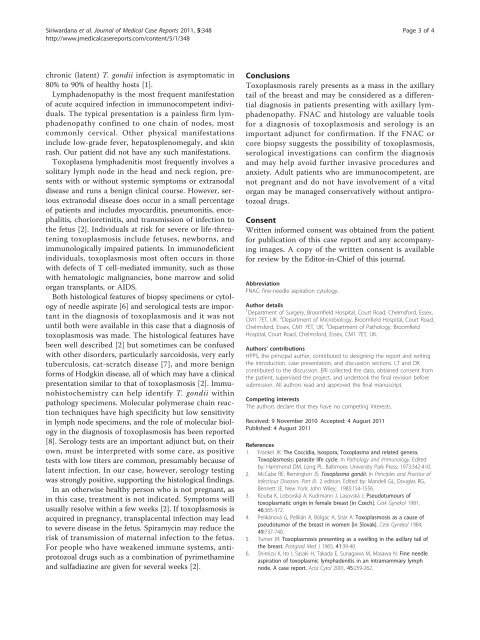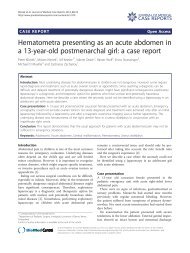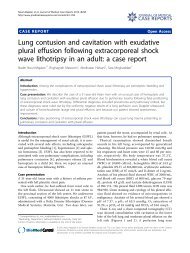Toxoplasmosis presenting as a swelling in the axillary tail of the ...
Toxoplasmosis presenting as a swelling in the axillary tail of the ...
Toxoplasmosis presenting as a swelling in the axillary tail of the ...
You also want an ePaper? Increase the reach of your titles
YUMPU automatically turns print PDFs into web optimized ePapers that Google loves.
Siriwardana et al. Journal <strong>of</strong> Medical C<strong>as</strong>e Reports 2011, 5:348<br />
http://www.jmedicalc<strong>as</strong>ereports.com/content/5/1/348<br />
Page 3 <strong>of</strong> 4<br />
chronic (latent) T. gondii <strong>in</strong>fection is <strong>as</strong>ymptomatic <strong>in</strong><br />
80% to 90% <strong>of</strong> healthy hosts [1].<br />
Lymphadenopathy is <strong>the</strong> most frequent manifestation<br />
<strong>of</strong> acute acquired <strong>in</strong>fection <strong>in</strong> immunocompetent <strong>in</strong>dividuals.<br />
The typical presentation is a pa<strong>in</strong>less firm lymphadenopathy<br />
conf<strong>in</strong>ed to one cha<strong>in</strong> <strong>of</strong> nodes, most<br />
commonly cervical. O<strong>the</strong>r physical manifestations<br />
<strong>in</strong>clude low-grade fever, hepatosplenomegaly, and sk<strong>in</strong><br />
r<strong>as</strong>h. Our patient did not have any such manifestations.<br />
Toxopl<strong>as</strong>ma lymphadenitis most frequently <strong>in</strong>volves a<br />
solitary lymph node <strong>in</strong> <strong>the</strong> head and neck region, presents<br />
with or without systemic symptoms or extranodal<br />
dise<strong>as</strong>e and runs a benign cl<strong>in</strong>ical course. However, serious<br />
extranodal dise<strong>as</strong>e does occur <strong>in</strong> a small percentage<br />
<strong>of</strong> patients and <strong>in</strong>cludes myocarditis, pneumonitis, encephalitis,<br />
chorioret<strong>in</strong>itis, and transmission <strong>of</strong> <strong>in</strong>fection to<br />
<strong>the</strong> fetus [2]. Individuals at risk for severe or life-threaten<strong>in</strong>g<br />
toxopl<strong>as</strong>mosis <strong>in</strong>clude fetuses, newborns, and<br />
immunologically impaired patients. In immunodeficient<br />
<strong>in</strong>dividuals, toxopl<strong>as</strong>mosis most <strong>of</strong>ten occurs <strong>in</strong> those<br />
with defects <strong>of</strong> T cell-mediated immunity, such <strong>as</strong> those<br />
with hematologic malignancies, bone marrow and solid<br />
organ transplants, or AIDS.<br />
Both histological features <strong>of</strong> biopsy specimens or cytology<br />
<strong>of</strong> needle <strong>as</strong>pirate [6] and serological tests are important<br />
<strong>in</strong> <strong>the</strong> diagnosis <strong>of</strong> toxopl<strong>as</strong>mosis and it w<strong>as</strong> not<br />
until both were available <strong>in</strong> this c<strong>as</strong>e that a diagnosis <strong>of</strong><br />
toxopl<strong>as</strong>mosis w<strong>as</strong> made. The histological features have<br />
been well described [2] but sometimes can be confused<br />
with o<strong>the</strong>r disorders, particularly sarcoidosis, very early<br />
tuberculosis, cat-scratch dise<strong>as</strong>e [7], and more benign<br />
forms <strong>of</strong> Hodgk<strong>in</strong> dise<strong>as</strong>e, all <strong>of</strong> which may have a cl<strong>in</strong>ical<br />
presentation similar to that <strong>of</strong> toxopl<strong>as</strong>mosis [2]. Immunohistochemistry<br />
can help identify T. gondii with<strong>in</strong><br />
pathology specimens. Molecular polymer<strong>as</strong>e cha<strong>in</strong> reaction<br />
techniques have high specificity but low sensitivity<br />
<strong>in</strong> lymph node specimens, and <strong>the</strong> role <strong>of</strong> molecular biology<br />
<strong>in</strong> <strong>the</strong> diagnosis <strong>of</strong> toxopl<strong>as</strong>mosis h<strong>as</strong> been reported<br />
[8]. Serology tests are an important adjunct but, on <strong>the</strong>ir<br />
own, must be <strong>in</strong>terpreted with some care, <strong>as</strong> positive<br />
tests with low titers are common, presumably because <strong>of</strong><br />
latent <strong>in</strong>fection. In our c<strong>as</strong>e, however, serology test<strong>in</strong>g<br />
w<strong>as</strong> strongly positive, support<strong>in</strong>g <strong>the</strong> histological f<strong>in</strong>d<strong>in</strong>gs.<br />
In an o<strong>the</strong>rwise healthy person who is not pregnant, <strong>as</strong><br />
<strong>in</strong> this c<strong>as</strong>e, treatment is not <strong>in</strong>dicated. Symptoms will<br />
usually resolve with<strong>in</strong> a few weeks [2]. If toxopl<strong>as</strong>mosis is<br />
acquired <strong>in</strong> pregnancy, transplacental <strong>in</strong>fection may lead<br />
to severe dise<strong>as</strong>e <strong>in</strong> <strong>the</strong> fetus. Spiramyc<strong>in</strong> may reduce <strong>the</strong><br />
risk <strong>of</strong> transmission <strong>of</strong> maternal <strong>in</strong>fection to <strong>the</strong> fetus.<br />
For people who have weakened immune systems, antiprotozoal<br />
drugs such <strong>as</strong> a comb<strong>in</strong>ation <strong>of</strong> pyrimetham<strong>in</strong>e<br />
and sulfadiaz<strong>in</strong>e are given for several weeks [2].<br />
Conclusions<br />
<strong>Toxopl<strong>as</strong>mosis</strong> rarely presents <strong>as</strong> a m<strong>as</strong>s <strong>in</strong> <strong>the</strong> <strong>axillary</strong><br />
<strong>tail</strong> <strong>of</strong> <strong>the</strong> bre<strong>as</strong>t and may be considered <strong>as</strong> a differential<br />
diagnosis <strong>in</strong> patients <strong>present<strong>in</strong>g</strong> with <strong>axillary</strong> lymphadenopathy.<br />
FNAC and histology are valuable tools<br />
for a diagnosis <strong>of</strong> toxopl<strong>as</strong>mosis and serology is an<br />
important adjunct for confirmation. If <strong>the</strong> FNAC or<br />
core biopsy suggests <strong>the</strong> possibility <strong>of</strong> toxopl<strong>as</strong>mosis,<br />
serological <strong>in</strong>vestigations can confirm <strong>the</strong> diagnosis<br />
and may help avoid fur<strong>the</strong>r <strong>in</strong>v<strong>as</strong>ive procedures and<br />
anxiety. Adult patients who are immunocompetent, are<br />
not pregnant and do not have <strong>in</strong>volvement <strong>of</strong> a vital<br />
organ may be managed conservatively without antiprotozoal<br />
drugs.<br />
Consent<br />
Written <strong>in</strong>formed consent w<strong>as</strong> obta<strong>in</strong>ed from <strong>the</strong> patient<br />
for publication <strong>of</strong> this c<strong>as</strong>e report and any accompany<strong>in</strong>g<br />
images. A copy <strong>of</strong> <strong>the</strong> written consent is available<br />
for review by <strong>the</strong> Editor-<strong>in</strong>-Chief <strong>of</strong> this journal.<br />
Abbreviation<br />
FNAC: f<strong>in</strong>e-needle <strong>as</strong>piration cytology.<br />
Author de<strong>tail</strong>s<br />
1 Department <strong>of</strong> Surgery, Broomfield Hospital, Court Road, Chelmsford, Essex,<br />
CM1 7ET, UK.<br />
2 Department <strong>of</strong> Microbiology, Broomfield Hospital, Court Road,<br />
Chelmsford, Essex, CM1 7ET, UK.<br />
3 Department <strong>of</strong> Pathology, Broomfield<br />
Hospital, Court Road, Chelmsford, Essex, CM1 7ET, UK.<br />
Authors’ contributions<br />
HPPS, <strong>the</strong> pr<strong>in</strong>cipal author, contributed to design<strong>in</strong>g <strong>the</strong> report and writ<strong>in</strong>g<br />
<strong>the</strong> <strong>in</strong>troduction, c<strong>as</strong>e presentation, and discussion sections. LT and DK<br />
contributed to <strong>the</strong> discussion. ERI collected <strong>the</strong> data, obta<strong>in</strong>ed consent from<br />
<strong>the</strong> patient, supervised <strong>the</strong> project, and undertook <strong>the</strong> f<strong>in</strong>al revision before<br />
submission. All authors read and approved <strong>the</strong> f<strong>in</strong>al manuscript.<br />
Compet<strong>in</strong>g <strong>in</strong>terests<br />
The authors declare that <strong>the</strong>y have no compet<strong>in</strong>g <strong>in</strong>terests.<br />
Received: 9 November 2010 Accepted: 4 August 2011<br />
Published: 4 August 2011<br />
References<br />
1. Frankel JK: The Coccidia, Isospora, Toxopl<strong>as</strong>ma and related genera.<br />
<strong>Toxopl<strong>as</strong>mosis</strong>; par<strong>as</strong>ite life cycle. In Pathology and Immunology. Edited<br />
by: Hammond DM, Long PL. Baltimore: University Park Press; 1973:342-410.<br />
2. McCabe RE, Rem<strong>in</strong>gton JS: Toxopl<strong>as</strong>ma gondii. In Pr<strong>in</strong>ciples and Practice <strong>of</strong><br />
Infectious Dise<strong>as</strong>es. Part III.. 2 edition. Edited by: Mandell GL, Dougl<strong>as</strong> RG,<br />
Bennett JE. New York: John Wiley; 1985:154-1556.<br />
3. Kouba K, Lobovská A, Kudrmann J, L<strong>as</strong>ovská J: Pseudotumours <strong>of</strong><br />
toxopl<strong>as</strong>matic orig<strong>in</strong> <strong>in</strong> female bre<strong>as</strong>t [<strong>in</strong> Czech]. Cesk Gynekol 1981,<br />
46:365-372.<br />
4. Pelikánová G, Pelikán A, Bolgác A, Sitár A: <strong>Toxopl<strong>as</strong>mosis</strong> <strong>as</strong> a cause <strong>of</strong><br />
pseudotumor <strong>of</strong> <strong>the</strong> bre<strong>as</strong>t <strong>in</strong> women [<strong>in</strong> Slovak]. Cesk Gynekol 1984,<br />
49:737-740.<br />
5. Turner JR: <strong>Toxopl<strong>as</strong>mosis</strong> <strong>present<strong>in</strong>g</strong> <strong>as</strong> a <strong>swell<strong>in</strong>g</strong> <strong>in</strong> <strong>the</strong> <strong>axillary</strong> <strong>tail</strong> <strong>of</strong><br />
<strong>the</strong> bre<strong>as</strong>t. Postgrad Med J 1965, 41:39-40.<br />
6. Shimizu K, Ito I, S<strong>as</strong>aki H, Takada E, Sunagawa M, M<strong>as</strong>awa N: F<strong>in</strong>e needle<br />
<strong>as</strong>piration <strong>of</strong> toxopl<strong>as</strong>mic lymphadenitis <strong>in</strong> an <strong>in</strong>tramammary lymph<br />
node. A c<strong>as</strong>e report. Acta Cytol 2001, 45:259-262.








